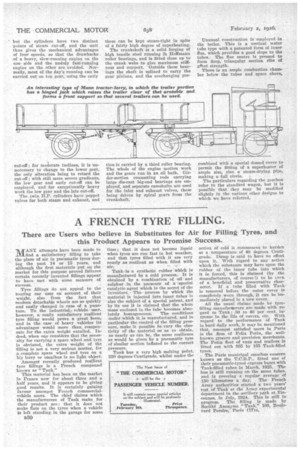A FRENCH TYRE FILLING.
Page 14

If you've noticed an error in this article please click here to report it so we can fix it.
There are Users who believe in Substitutes for Air for Filling Tyres, and this Product Appears to Promise Success.
MANY attempts have been made to find a satisfactory filling to take the place of air in pneumatic tyres during the past 14 or 15 years, and although the first materials put on the market for this purpose proved failures certain recently invented fillings appear to have met with some measure of success.
Tyre fillings do not appeal to the touring car user on' account of their weight, also from the fact that modern detachable wheels are so quickly and easily (hanged in case of a puncture. To the industrial vehicle user, however, a really satisfactory resilient tyre filling would prove a great boon; and in the case of heavy vehicles its advantages would more than, compensate for the extra weight entailed. In, deed, when one considers that the necessity for carrying a spare wheel and tyre is obviated, the extra weight of the filling is not a very serious matter, for a complete spare wheel and tyre on a big lorry or omnibus is no light object.
Amongst recently produced resilient tyre fillings is a French compound known as "Tank," This material has been oat the market in France now for about three and a half years. and it appears to be giving good results. It is certainly gaining favour amongst French commercialvehicle users. The chief claims which the manufacturers of Tank make for their product are : that it does not make flats on the tyres when a vehicle is left standing in the garage for some time ; that it does not become liquid when tyres are run fast in hot weather, and that tyres filled with it are very nearly as resilient as when filled with air.
Tank,is a synthetic rubber which is manufactured by a cold process. It is obtained by a combination of oil and sulphur in the presence of a special catalytic agent which is the secret of the inventors.' The process by which the material is injected into inner tubes is also the subject of a special patent, and by its use it is claimed that the whole mass enclosed in the tube becomes abso lutely homogeneous. The conditions under which it is manufactured, and in particular the control of the filling pressure, make it possible to vary the elasticity of the material so as to obtain, as nearly as can be, the same resilience as would be given by a pneumatic tyre of similar section inflated to the correct pressure.
Tank has a very high melting point, 220 degrees Centigrade, whilst under the action of cold it commences, to harden at a temperature of 40 degrees Centigrade. Damp is said to have no effect upon it. With regard to any action which the substance may have upon the rubber of the inner tube into which it is forced, this is claimed (by the manufacturers, of course!) to be even of a beneficial and preservative character. If a tube filled with Tank is removed before the outer cover is completely worn through, it can be immediately placed in a new cover.
All the usual claims made by tyrefilling manufaeturers are made with regard to Tank ; 30 to 40 per cent_ increase in the life of covers, etc. With regard to the performance of Tank in hard 'daily work, it may be mentioned that, amongst satisfied users in Paris is the firm of _Felix Potin, the wellknown grocers and provision merchants. The Potin fleet of vans and trailers is fitted out with 955 by 155 Tank-filled tyres.
The Paris municipal omnibus concern known as the T.C.R.P., fitted one of their pheumatic-tyred express buses with Tank-filled tubes in March, 1925. The bus is still running on the same tubes, and is covering a regular average of 350 kilometres a day. The French Army authorities started a two years' test of Tank at the Army experimental department in the artillery park at Vincennes, in Slily, 1924. This is still in Progress. The filling is made by Societ6 Anonyme "Tank," 109, Boule
vard Pereire, Paris (17)e. "






























